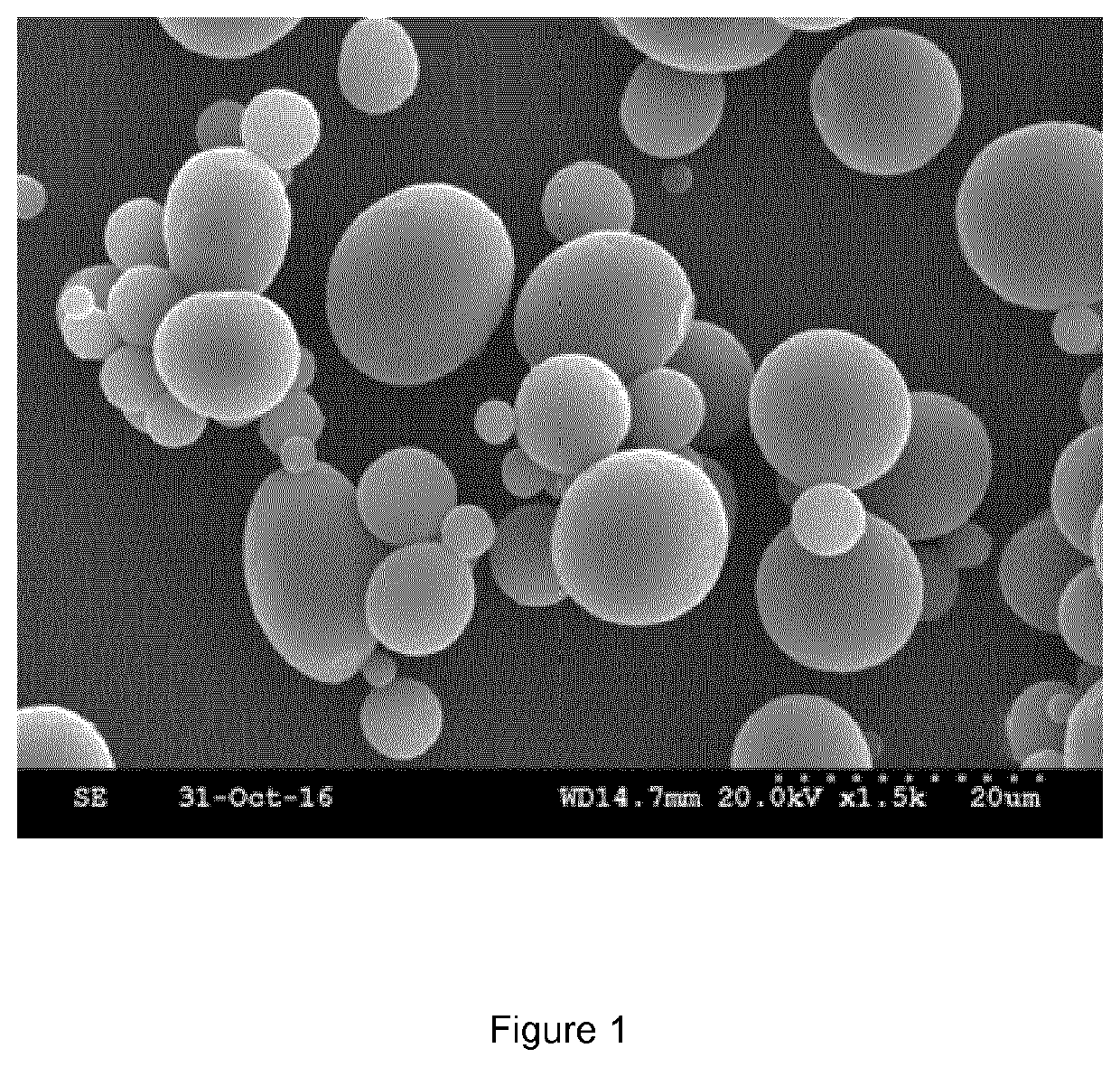Process for preparing particles of polyphenylene sulfide polymer
- Summary
- Abstract
- Description
- Claims
- Application Information
AI Technical Summary
Benefits of technology
Problems solved by technology
Method used
Image
Examples
example 1
[0129]Raw Materials
[0130]PPS: Ryton® QC160N commercially available from Solvay Specialty Polymers USA, L.L.C.
[0131]PE: Sulfopolyester Eastman AQ™ 48 commercially available from Eastman. This PE is composed of diethylene glycol, cyclohexanedimethanol (CHDM), isophthalates and sulfoisophthalates units. According to 1H NMR analysis, the molar concentration of diethylene glycol of 70 mol. %, based on the total moles of diols (CHMD+diethylene glycol).
[0132]PTS: Para toluene sulfonate from Spectrum Chemical.
[0133]Material Processing
[0134]Blends were made according to Table 1.
[0135]15 g of each composition was melt-blended during 3 minutes in a DSM Xplore® Micro-compounder at a specific temperature (see Table 1) and at 150-200 rpm. Each blend was then processed into strands and then quenched in air until solid. Samples were immersed into water heated to 95° C., for 2 hours. Water was then removed. Samples were immersed again into water heated at 90° C., for 2 hours.
[0136]Some compositions ...
example 2
[0142]This example aims at demonstrating that the modified PET component described in JP2014043522 does not dissolve in water heated to a temperature of 95° C.
[0143]Raw Materials
[0144]PET: Estar® Polyester EN052, commercially available from Eastman
[0145]Chemical
[0146]DMSI: Dimethyl 5-sulfoisophthalate sodium salt (purity 98%, Mw: 296.23), commercially available from Alfa Aesar
[0147]Process of Preparation of the Modified PET
[0148]13 g of PET (90 mol. %) and 2.3 g of DMSI (10 mol. %) were melt-blended in a DSM micro-compounder at 310° C. during 4 to 8 minutes.
[0149]Water-Solubility Test
[0150]All samples were exposed to a water bath heated to 80° C. for 1 hour at the following condition: 0.5 g of material and 10 g of deionised water.
TABLE 3PETDMSITime of melt-(mol. %)(mol. %)blending (min)Water solubility testA90104The modified PET did not dissolveB90106The modified PET did not dissolveC90108The modified PET did not dissolve
example 3
[0151]Raw Materials
[0152]PPS: Ryton® QC160N commercially available from Solvay Specialty Polymers USA, L.L.C.
[0153]PE: Sulfopolyester Eastman AQ™ 38 S commercially available from Eastman. This PE is composed of diethylene glycol, cyclohexanedimethanol (CHDM), isophthalates and sulfoisophthalates units. According to 1H NMR analysis, the molar concentration of diethylene glycol of 80 mol. %, based on the total moles of diols (CHMD+diethylene glycol).
[0154]Material Processing
[0155]Blends were made according to Table 4.
[0156]Each composition was melt-blended in a ZSK-26 Twin Screw Extruder (Coperion) at specific conditions indicated in Table 4.
[0157]Each polymer melt was dropped from the extruder die in a bucket of hot water (60° C.) with occasional mixing. Powders were isolated by vacuum filtration employing a Buchner funnel. Powders were then washed with 2-3 L of deionized water in the Buchner funnel. Powders were dried at 100° C. and reduced pressure. Each polymer was mixed with coll...
PUM
| Property | Measurement | Unit |
|---|---|---|
| Temperature | aaaaa | aaaaa |
| Temperature | aaaaa | aaaaa |
| Temperature | aaaaa | aaaaa |
Abstract
Description
Claims
Application Information
 Login to View More
Login to View More - R&D Engineer
- R&D Manager
- IP Professional
- Industry Leading Data Capabilities
- Powerful AI technology
- Patent DNA Extraction
Browse by: Latest US Patents, China's latest patents, Technical Efficacy Thesaurus, Application Domain, Technology Topic, Popular Technical Reports.
© 2024 PatSnap. All rights reserved.Legal|Privacy policy|Modern Slavery Act Transparency Statement|Sitemap|About US| Contact US: help@patsnap.com










